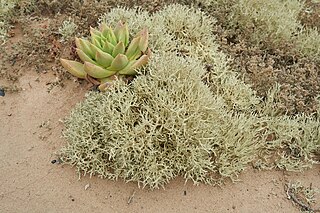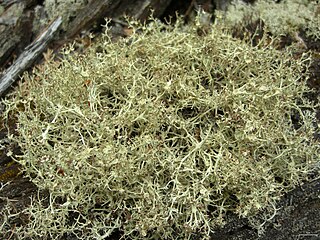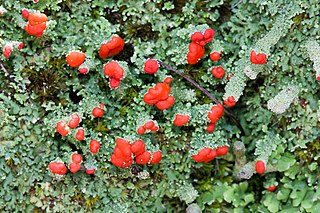
A lichen is a symbiosis of algae or cyanobacteria living among filaments of multiple fungi species, along with a yeast embedded in the cortex or "skin", in a mutualistic relationship. Lichens are important actors in nutrient cycling and act as producers which many higher trophic feeders feed on, such as reindeer, gastropods, nematodes, mites, and springtails. Lichens have properties different from those of their component organisms. They come in many colors, sizes, and forms and are sometimes plant-like, but are not plants. They may have tiny, leafless branches (fruticose); flat leaf-like structures (foliose); grow crust-like, adhering tightly to a surface (substrate) like a thick coat of paint (crustose); have a powder-like appearance (leprose); or other growth forms.

Cladonia is a genus of moss-like lichens in the family Cladoniaceae. They are the primary food source for reindeer/caribou. Cladonia species are of economic importance to reindeer-herders, such as the Sami in Scandinavia or the Nenets in Russia. Antibiotic compounds are extracted from some species to create antibiotic cream. The light green species Cladonia stellaris is used in flower decorations.

Cetraria islandica, also known as true Iceland lichen or Iceland moss, is an Arctic-alpine lichen whose erect or upright, leaflike habit gives it the appearance of a moss, where its name likely comes from.

Ethnolichenology is the study of the relationship between lichens and people. Lichens have and are being used for many different purposes by human cultures across the world. The most common human use of lichens is for dye, but they have also been used for medicine, food and other purposes.

Edible lichens are lichens that have a cultural history of use as a food. Although almost all lichen are edible, not all have a cultural history of usage as an edible lichen. Often lichens are merely famine foods eaten in times of dire needs, but in some cultures lichens are a staple food or even a delicacy. Some lichens are a source of vitamin D.

Cladonia stellaris or the star-tipped cup lichen is an ecologically important species of cup lichen that forms continuous mats over large areas of the ground in boreal and arctic regions around the circumpolar north. The species is a preferred food source of reindeer and caribou during the winter months, and it has an important role in regulating nutrient cycling and soil microbiological communities. Like many other lichens, Cladonia stellaris is used by humans directly for its chemical properties, as many of the secondary metabolites are antimicrobial, but it also has the unique distinction of being harvested and sold as 'fake trees' for model train displays. It is also used as a sound absorber in interior design. The fungal portion of Cladonia stellaris, known as a mycobiont, protects the lichen from lichenivores, superfluous solar radiation, and other kinds of stressors in their ecosystem.

Peltigera aphthosa is a species of lichen known by the common names green dog lichen, leafy lichen, felt lichen, and common freckle pelt. It has a circumpolar distribution, occurring throughout the Arctic, boreal, and temperate regions of the Northern Hemisphere.

Lichens are symbiotic organisms made up of multiple species: a fungus, one or more photobionts and sometimes a yeast. They are regularly grouped by their external appearance – a characteristic known as their growth form. This form, which is based on the appearance of vegetative part of the lichen, varies depending on the species and the environmental conditions it faces. Those who study lichens (lichenologists) have described a dozen of these forms: areolate, byssoid, calicioid, cladoniform, crustose, filamentous, foliose, fruticose, gelatinous, leprose, placoidioid and squamulose. Traditionally, crustose (flat), foliose (leafy) and fruticose (shrubby) are considered to be the three main forms. In addition to these more formalised, traditional growth types, there are a handful of informal types named for their resemblance to the lichens of specific genera. These include alectorioid, catapyrenioid, cetrarioid, hypogymnioid, parmelioid and usneoid.
Vermilacinia ceruchoides is a fruticose lichen found on rock faces of cliffs or boulders, sometimes growing among mosses, usually near the ocean, ranging in distribution from Marin County, California to San Vicente on the northern peninsula of Baja California, and in the Channel Islands.

Niebla arenaria is a fruticose lichen that grows along the Pacific Coast of North America in the fog regions of the northern peninsula of Baja California from near Colonet south to Morro Santo Domingo. The epithet, arenaria, is in regard to the species growing on sand.
Niebla brachyura is a rare fruticose lichen that grows along the Pacific Coast of North America in the fog regions of the northern peninsula of Baja California in the Northern Vizcaíno Desert. The epithet, brachyura, is in regard to the species resembling a crab lying on its back with its leg appendages pointing up.

Cladonia parasitica, commonly known as the fence-rail cladonia, fence-rail cup lichen or parasite club lichen, is a species of fruticose, cup lichen in the family Cladoniaceae. It was first described by Hoffmann in 1784 under the name Lichen parasiticus, until he reclassified it under the genus Cladonia in 1795.

Cladonia amaurocraea, commonly known as the quill lichen or the quill cup lichen, is a species of fruticose, cup lichen in the Cladoniaceae family.

Cladonia arbuscula, also referred to as shrubby cup lichen or green reindeer lichen, is a species of cup lichen in the family Cladoniaceae.
Lichenopeltella rangiferinae is a species of fungus belonging to the class Dothideomycetes. It was discovered growing on Cladonia rangiferina in Hrútey near Blönduós, Iceland and subsequently described as new to science in 2011.
Lichenopeltella uncialicola is a species of fungus belonging to the class Dothideomycetes. The species was discovered in Iceland in 2010 where it was found growing on Cladonia uncialis. Since then, it has been found on a different host species, Cladonia rangiferina, in North-Korea, Italy Austria, and Greenland.

Lichenoconium pyxidatae is a species of lichenicolous fungus belonging to the class Dothideomycetes. It has a Holarctic distribution being found in Alaska and various parts of Russia, including Siberia, Franz Josef Land, Novaya Zemlya and Wrangel Island.

Pulchrocladia retipora, commonly known as the coral lichen, is a species of fruticose lichen in the family Cladoniaceae. Found predominantly in Australasia, its habitats range from the Australian Capital Territory to New Zealand's North and South Islands, and even the Pacific region of New Caledonia, where it grows in coastal and alpine heathlands. The lichen features coral-like branches and subbranches with numerous intricate, netlike perforations. It is known by multiple names, with some sources referring to it by its synonym Cladia retipora, or the common name lace lichen.

Cladonia rei, commonly known as the wand lichen, is a species of ground-dwelling, fruticose lichen in the family Cladoniaceae. It is a widely distributed species, having been reported from Africa, Asia, Australasia, Europe, and North America. It is identified by its slightly dirty-colored, rough-surfaced, slender podetia that grow up to 9 cm (3.5 in) tall. Diagnostic characters of the lichen include the continuously sorediate, green-and-brown-mottled, podetia that taper upward to a point, while chemically, it contains homosekikaic and sekikaic acids. Its reduced capacity to bioaccumulate toxic heavy metals from its surroundings, as well as its ability to switch photobiont partners, allows the lichen to colonize and survive highly polluted habitats. There are several other Cladonia species that are somewhat similar in appearance, but can be distinguished either by subtle differences in morphology, or by the secondary chemicals they contain.

Cladonia didyma is a fruticose lichen, commonly known as southern soldiers, belonging to the family Cladoniaceae, which include fungal symbionts under the Ascomycota phylum with characteristic red ascocarps containing sexually reproductive asci.


















